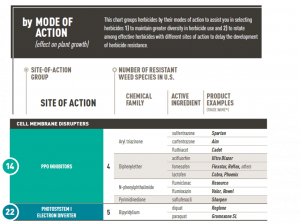Chapter 19: MOA Part 4 – Photosynthesis Inhibitors (Photosystems)
19.6 Herbicides that Interfere with Photosystem I

Herbicides in Site of Action Group 22, such as paraquat and diquat, interact with the electron transfer components associated with Photosystem I. Under normal circumstances, the electrons pumped to high energy by P-700 are transferred to ferredoxin, which in turn transfers electrons to NADP+, forming NADPH. These high energy electrons are the source of energy for cellular biosynthesis. When paraquat or diquat is present, it interacts with ferredoxin, competing with NADP+ as an electron acceptor. When the herbicide is reduced by an electron, it rapidly transfers the electron to oxygen, forming highly reactive superoxide. This initiates a cascade of free radical reactions that causes extensive cellular damage. Thus, the herbicide uncouples the energy of photosynthesis from the cellular biosynthetic machinery, and the energy proves to be lethal for the plant cell.

Review and Reflection
Photosystem I Inhibitors – Group 22